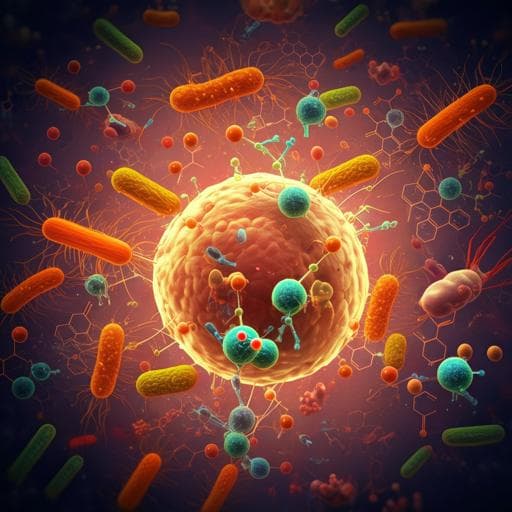
Medicine and Health
Alterations in the gut microbiota and metabolite profiles of patients with Kashin-Beck disease, an endemic osteoarthritis in China
X. Wang, Y. Ning, et al.
Discover groundbreaking insights into Kashin-Beck disease (KBD), an osteochondral disorder influenced by genetic and environmental factors. This study, conducted by Xi Wang and colleagues, reveals a unique interplay between gut microbiota and serum metabolites, highlighting how altered lipid metabolism could guide future treatments.
~3 min • Beginner • English
Introduction
Kashin-Beck disease (KBD) is an endemic degenerative osteochondrosis characterized by progressive cartilage damage with clinical features such as shortened/enlarged fingers, joint deformities, and limited movement. Despite evidence implicating metabolic dysregulation, apoptosis, immune responses, cytoskeletal changes, and ECM turnover in chondrocyte injury, the underlying mechanisms remain unclear and treatments are limited. Emerging data suggest a cartilage–gut–microbiome axis whereby gut microbiome composition and metabolic activity modulate immune tone and systemic metabolites, potentially driving low-grade inflammation and cartilage injury. Environmental factors, notably dietary selenium deficiency and exposure to Fusarium mycotoxins, have been implicated as KBD risk factors. This study asks how gut microbiota composition differs in KBD (by clinical grade) compared with healthy controls, how microbial functional potential is altered, how circulating metabolite profiles differ, and whether specific microbiota–metabolite correlations suggest mechanistic links relevant to KBD pathogenesis.
Literature Review
The gut microbiota in health is dominated by Firmicutes and Bacteroidetes with key genera such as Bacteroides, Faecalibacterium, and Bifidobacterium. Prior studies in arthritis models and rheumatoid arthritis patients have reported shifts in Bacteroidaceae and Firmicutes, and associations with Prevotella copri. Diet is a major determinant of gut microbiota; selenium deficiency and Fusarium mycotoxins have long been linked to KBD. Selenium can modulate microbiome diversity, and probiotics can incorporate selenium, potentially synergizing to restore gut homeostasis. Masked mycotoxins can be hydrolyzed by gut microbes, potentially altering systemic exposure. Lipid metabolism alterations, including glycerophospholipids and sphingomyelins, have been implicated in osteoarthritis pathophysiology, with lysoPCs correlating with disease severity. These lines of evidence motivate integrated microbiome–metabolome profiling in KBD.
Methodology
Study design and participants: Adults from Xunyi County (endemic KBD area, Shaanxi, China) were recruited. After strict inclusion/exclusion criteria and matching of demographics and diet, 32 KBD patients and 35 normal controls (NCs) were selected for 16S rDNA microbiome and serum LC/MS metabolomics. For metagenomics, fecal samples from 16 grade I KBD, 16 grade II KBD, and 35 NCs were analyzed.
Sample collection: Self-collected stool samples were promptly frozen in liquid nitrogen and stored at -80°C. Venous blood (5–7 ml) was collected, processed to serum via serial centrifugations, snap-frozen, and stored at -80°C.
16S rDNA sequencing: DNA was extracted (E.Z.N.A. Stool DNA Kit). The V3–V4 region was amplified (primers 341F/805R), amplicons purified and quantified, and sequenced on Illumina NovaSeq PE250. Reads were demultiplexed, merged (FLASH), quality filtered (fqtrim), de-duplicated and denoised (DADA2), and chimeras removed (Vsearch). Feature tables and taxonomy (SILVA/NT-16S) were generated in QIIME2. Alpha/beta diversity, UniFrac PCoA, and LEfSe were performed; PICRUSt2 predicted functional profiles (COG, EC, KEGG, KO, PFAM, TIGRFAM). Random forest models and ROC analysis evaluated discriminatory genera.
Shotgun metagenomics: Libraries (TruSeq Nano) were prepared from fecal DNA, sequenced, adapters trimmed (cutadapt), low-quality bases removed (fqtrim), host reads filtered (bowtie2), and reads de novo assembled (IDBA-UD). Coding sequences were predicted (MetaGeneMark) and clustered into unigenes (CD-HIT). Abundances were estimated (TPM via bowtie2 mappings). Taxonomy was assigned against NCBI NR (DIAMOND). Functional annotation used GO, KEGG, eggNOG, CAZy, CARD, PHI, MGES, and VFDB. Differential analyses (Fisher’s exact test) identified significantly different unigenes, taxa, and pathways. Diversity metrics (Shannon, Simpson, Chao1) and Bray–Curtis PCoA were computed.
Serum LC/MS metabolomics: UPLC (ACQUITY BEH Amide column) coupled to SCIEX TripleTOF5600+ operated in positive/negative modes with defined gradients and source settings. Data were acquired in IDA mode with dynamic exclusion and regular mass calibration. Quality control (pooled) samples were injected every 10 runs.
Metabolomics data processing: Raw files were converted to mzXML and processed with XCMS/CAMERA/metaX (peak picking, grouping, RT correction, annotation). Features present in <50% of QCs or <80% of biologicals were removed; missing values imputed (kNN). QC-based LOESS signal correction and RSD filtering (>30% removed). Metabolite annotation used KEGG/HMDB and an in-house MS/MS library (≤10 ppm mass error, isotope pattern checks). Statistical analysis: Student’s t-tests with FDR correction; supervised PLS-DA; VIP ≥1 and fold change >2 defined differentially regulated metabolites (DRMs). Spearman correlations linked top species (metagenomics) with significant metabolites. Statistical tools included GraphPad Prism, R (v3.5.2), and Microsoft Excel. Ethics approval and informed consent were obtained.
Key Findings
- Cohorts: 32 KBD and 35 NC participants; 5,513,088 high-quality 16S reads (median 55,687/sample). Metagenomics on 16 grade I KBD, 16 grade II KBD, and 35 NCs predicted 578,718 genes.
- 16S microbiome composition: 18 phyla detected per group. KBD showed elevated Bacteroidetes (21.18% vs 7.98% in NC) and Actinobacteria (25.66% vs 24.78%), and reduced Firmicutes (45.88% vs 65.06%). Fusobacteria was higher in KBD. NC displayed a significantly higher Firmicutes/Bacteroidetes ratio than KBD. Beta-diversity (UniFrac PCoA) differed significantly between groups (ANOSIM unweighted R=0.1332, P=0.001; weighted R=0.2505, P=0.001). No significant alpha-diversity differences by 16S.
- Differential taxa: 56 genera differed between KBD and NC. Enriched in KBD: Alloprevotella, Robinsoniella, Megamonas, Escherichia_Shigella, Prevotella_9, Fusobacterium, Actinomyces, Muribaculaceae_unclassified. Enriched in NC: Clostridium_sensu_stricto_1, Agathobacter, Coprococcus_3, Fusicatenibacter, Lachnospira, Roseburia, Faecalibacterium, Ruminococcaceae_UCG_013, Ruminococcus_2, Subdoligranulum. LEfSe highlighted higher Bacteroidetes and Prevotella_9 in KBD and lower Firmicutes.
- Diagnostic modeling: Random forest using 20 genera best discriminated KBD vs NC. Top single-genus ROC AUCs: Coprococcus_3 (0.804), Agathobacter (0.786), Subdoligranulum (0.784).
- PICRUSt2 functional prediction: Differences included L-glutamate/L-glutamine biosynthesis and polyisoprenoid biosynthesis (KEGG), and superfamily II DNA/RNA helicases and ADP-glucose pyrophosphorylase (COG).
- Shotgun metagenomics: Markedly lower alpha diversity in grade I and II KBD vs NC (Shannon, Simpson, Chao1; P<0.05). PCoA (Bray–Curtis) separated groups (ANOSIM R=0.4, P=0.001). Differential unigenes vs NC: grade I KBD (n=101,153; 11,655 up, 89,498 down), grade II KBD (n=60,925; 5,199 up, 55,726 down); between grade I vs II KBD (n=21,875; 11,643 up, 10,232 down). Species shifts: decreased Bacteroides vulgatus, B. stercoris, B. dorei in grade I KBD vs NC; increased Prevotella copri, P. copri-CAG:164, Prevotella sp. AM23-5, Prevotella sp.-CAG:386 in grade II KBD vs NC; relative reductions of multiple Bacteroides in grade I vs II and Collinsella species in grade II vs I.
- Metagenomic functional KEGG pathways: Grade I KBD vs NC—starch/sucrose metabolism, galactose metabolism, sphingolipid metabolism; Grade II KBD vs NC—ABC transporters, two-component system, bacterial chemotaxis; Grade I vs II KBD—ribosome, glutathione metabolism, vitamin B6 metabolism.
- Serum metabolomics: DRMs identified—KBD vs NC (178), grade I vs NC (285), grade II vs NC (191), grade I vs grade II (305). Common altered metabolites included higher gamma-linolenic acid, palmitelaidic acid, 3-oxooctadecanoic acid, oleic acid, and lower taurochenodeoxycholate-3-sulfate and Phe-Phe in KBD vs NC. Enriched KEGG pathways: biosynthesis of unsaturated fatty acids (4 metabolites), glycerophospholipid metabolism (3), linoleic acid metabolism (2), indicating lipid metabolism disturbance.
- Microbiome–metabolite correlations: In grade I KBD vs NC, unsaturated fatty acids (docosapentaenoic, palmitelaidic, gamma-linolenic, oleic, (E)-13-hydroxy-10-oxo-11-octadecenoic acid) negatively correlated with Paenibacillus montanisoli and positively with Buttiauxella brennerae. Lyso-lipids (LysoPE 20:5, LysoPC 20:5, LysoPI 20:5) negatively correlated with Parvimonas sp. KA00067 and positively with Rothia sp. HMSC065C03. Between grade I and II KBD, acylcarnitines and lysolecithins positively correlated with Prevotella sp. P5-60 and Rothia sp. HMSC065C03 and negatively with Bacteroides sp. AM25-34 and Parabacteroides sp. AF18-52.
Discussion
This integrated multi-omics study demonstrates that KBD is associated with gut dysbiosis across phylum, genus, and species levels, featuring reduced Firmicutes, elevated Bacteroidetes and Fusobacteria, and depletion of health-associated butyrate producers (e.g., Faecalibacterium, Roseburia). Shotgun metagenomics confirms reduced microbial diversity and broad functional alterations, including carbohydrate and sphingolipid metabolism and bacterial signaling systems. Concomitantly, serum metabolomics reveals prominent disturbances in lipid and lipid-like metabolites—unsaturated fatty acids, glycerophospholipids, sphingolipids—implicated in cartilage biology and osteoarthritis pathophysiology. Correlation analyses link specific taxa (e.g., Prevotella, Bacteroides, Rothia, Parvimonas) to lipid metabolites (lysoPCs, acylcarnitines, UFAs), supporting a microbiome–metabolome interplay that could influence chondrocyte inflammation, apoptosis, and matrix turnover. These findings align with the hypothesized cartilage–gut–microbiome axis and suggest that environmental exposures relevant to KBD (selenium deficiency, Fusarium mycotoxins) may perturb the microbiota, alter metabolite processing (e.g., masked mycotoxin hydrolysis), and contribute to joint damage. While causality is not established, the data provide mechanistic leads and candidate microbial/metabolic biomarkers for KBD risk stratification and therapeutic targeting.
Conclusion
KBD patients exhibit significant gut microbiota dysbiosis and serum metabolic alterations, particularly in lipid metabolism, with distinct profiles across clinical grades. Multi-omics integration highlights specific microbial taxa and functional pathways associated with differentially regulated lipid metabolites, suggesting a microbiome–metabolome link in KBD pathogenesis. The study proposes a hypothetical model in which environmental factors (selenium deficiency, Fusarium mycotoxins) disrupt the gut microbiota, modify metabolite processing, and promote cartilage injury. Future research should employ larger, longitudinal cohorts; interventional studies (e.g., dietary selenium, probiotics, microbiome modulation); mechanistic experiments to test causality (gnotobiotic/animal models); and validation of microbial and metabolic biomarkers for diagnosis and monitoring.
Limitations
- Small sample size (32 KBD, 35 NC for 16S/metabolomics; 16 grade I KBD, 16 grade II KBD, 35 NC for metagenomics) due to declining KBD incidence, mortality in older cohorts, and stringent inclusion criteria.
- Potential overlap of adult KBD pathology with osteoarthritis complicates case identification.
- Cross-sectional design precludes causal inference; environmental exposures and diet, though matched, may still confound.
- Metabolite identification relies partly on database matching; not all features confirmed with standards.
Related Publications
Explore these studies to deepen your understanding of the subject.







